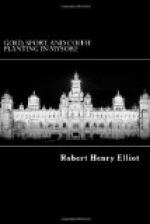plants is probably the very earliest tradition connected
with gold, and it is not improbable that the circumstance
may have been one of the means of calling attention
to the existence of gold in Mysore. An account
of this tradition is to be found in the “Selections
from the Records of the Mysore Government,"[25] and
from them it appears that Lieutenant John Warren,
when he was employed in surveying the eastern boundary
of Mysore in 1800, was told by a Brahman that “In
prosperous years when the gods favoured the Zillah
of Kadogi (a small village on the west bank of the
Pennar river, Hoskote Talook, 15 miles from Bangalore)
with an ample harvest now and then grains of gold
were found on the ears of the paddy (rice plants)
grown under the tank lying close to the north of that
village.” And in this connection I may
mention that, when visiting the Kolar mines last January,
I found, in the course of a conversation with the head
man of the village of Ooregum, that he was aware of
this tradition, and that grains of gold were said
to have been seen on the rice plants at a village about
fifteen miles distant from his own. The explanation
of this is extremely simple, as the rice plants are
usually grown in nurseries and transplanted in bunches
of several plants, after which the fields are flooded,
and in heavy floods (and this accounts for the gold
having been found in the years which are prosperous
from the abundant rain) the plants would often be
quite submerged. With the water no doubt came
grains of gold, which were deposited on the rice plants,
and as these grew, the grains of gold would naturally
rise with them, and thus often be found adhering to
the roughly-coated grain.
After the attention of Lieutenant Warren was called
to the subject, he seems to have taken some trouble
in investigating it, and having heard a vague report
that gold had been found in the earth somewhere near
a small hill about nine miles east of Budiakote, offered
a reward for information regarding this, and shortly
afterwards a ryot of the village offered to show him
the place, which was close to his village. He
visited the spot in question on February 17th, 1802,
“when the women of the village were assembled,
and, each being provided with a small broom and vaning
basket, and hollow board to receive the earth, they
went to a jungle on the west of the village.
Here they entered some small nullahs, or rather breaks
in the ground, and removing the gravel with their
hands, they swept the earth underneath into their
vaning baskets, by the help of which they further
cleared it of the smaller stones and threw it into
the hollow board above mentioned. Having thus
got enough earth together, they adjourned to a tank
and placed the hollow boards containing the earth in
the water, but just deep enough for it to overflow
when resting on the ground, and no more. Then
they stirred the earth with the hand, but keeping it
over the centre of the board, so that the metal should
fall into the depression by its own weight, and the




